New Insight on Terahertz Rectification in a Metal–Oxide–Semiconductor Field-Effect Transistor Structure
Abstract
:1. Introduction
2. Analytical Interpretation and Numerical Simulator
3. Simulation of THz Rectification in MOS-FET Structure
3.1. Self-Mixing Effects Iside the Silicon Structure
3.2. Rectification Effects at the Contacts
4. Conclusions
Funding
Acknowledgments
Conflicts of Interest
References
- Guerboukha, H.; Nallappan, K.; Skorobogatiy, M. Toward real-time terahertz imaging. Adv. Opt. Photon. 2018, 10, 843–938. [Google Scholar] [CrossRef]
- Islam, M.S.; Cordeiro, C.M.; Franco, M.A.; Sultana, J.; Cruz, A.L.; Abbott, D. Terahertz optical fibers. Opt. Express 2019, 28, 16089–16117. [Google Scholar] [CrossRef] [PubMed]
- Zaytsev, K.I.; Dolganova, I.N.; Chernomyrdin, N.V.; Katyba, G.M.; Gavdush, A.A.; Cherkasova, O.P.; Komandin, G.; Shchedrina, M.A.; Khodan, A.N.; Ponomarev, D.S.; et al. The progress and perspectives of terahertz technology for diagnosis of neoplasms: A review. J. Opt. 2019, 22, 013001. [Google Scholar] [CrossRef]
- Smolyanskaya, O.; Chernomyrdin, N.; Konovko, A.; Zaytsev, K.I.; Ozheredov, I.; Cherkasova, O.P.; Nazarov, M.M.; Guillet, J.-P.; Kozlov, S.; Kistenev, Y.V.; et al. Terahertz biophotonics as a tool for studies of dielectric and spectral properties of biological tissues and liquids. Prog. Quantum Electron. 2018, 62, 1–77. [Google Scholar] [CrossRef]
- Yachmenev, A.E.; Lavrukhin, D.V.; Glinskiy, I.A.; Zenchenko, N.V.; Goncharov, Y.G.; Spektor, I.E.; Khabibullin, R.A.; Otsuji, T.; Ponomarev, D.S. Metallic and dielectric metasurfaces in photoconductive terahertz devices: A review. Opt. Eng. 2019, 59, 061608. [Google Scholar] [CrossRef]
- Yachmenev, A.E.; Pushkarev, S.S.; Reznik, R.R.; Khabibullin, R.A.; Ponomarev, D.S. Arsenides-and related III-V materials-based multilayered structures for terahertz applications: Various designs and growth technology. Prog. Cryst. Growth Charact. Mater. 2020, 66, 100485. [Google Scholar] [CrossRef]
- Lepeshov, S.; Gorodetsky, A.; Krasnok, A.; Rafailov, E.U.; Belov, P. Enhancement of terahertz photoconductive antenna operation by optical nanoantennas. Laser Photon. Rev. 2016, 11, 1600199. [Google Scholar] [CrossRef] [Green Version]
- Dyakonov, M.; Shur, M. Detection, mixing, and frequency multiplication of terahertz radiation by two-dimensional electronic fluid. IEEE Trans. Electron Devices 1996, 43, 380–387. [Google Scholar] [CrossRef]
- Al Hadi, R.; Sherry, H.; Grzyb, J.; Baktash, N.; Zhao, Y.; Öjefors, E.; Pfeiffer, U. A broadband 0.6 to 1 THz CMOS imaging detector with an integrated lens. In Proceedings of the IEEE MTT-S International Microwave Symposium, Baltimore, MD, USA, 5–10 June 2011. [Google Scholar]
- Lisauskas, A.; Pfeiffer, U.; Ojefors, E.; Bolívar, P.H.; Glaab, D.; Roskos, H.G. Rational design of high-responsivity detectors of terahertz radiation based on distributed self-mixing in silicon field-effect transistors. J. Appl. Phys. 2009, 105, 114511. [Google Scholar] [CrossRef]
- Palma, F.; Rao, R. A model of high-frequency self-mixing in double-barrier rectifier. J. Infrared Millimeter Terahertz Waves 2018, 39, 422–438. [Google Scholar] [CrossRef] [Green Version]
- Palma, F.; Rao, R. Terahertz detection in MOS-FET: A new model by the self-mixing. In Proceedings of the 43rd International Conference on Infrared, Millimeter, and Terahertz Waves (IRMMW-THz), Nagoya, Japan, 9–14 September 2018; pp. 1–3. [Google Scholar]
- Palma, F. Self-mixing model of terahertz rectification in a metal oxide semiconductor capacitance. Electronics 2020, 9, 479. [Google Scholar] [CrossRef] [Green Version]
- Synopsys Inc. Sentaurus Device, User Manual, Version Y-2006; Synopsys Inc.: Mountain View, CA, USA, 2006. [Google Scholar]
- Stratton, R. Diffusion of hot and cold electrons in semiconductor barriers. Phys. Rev. 1962, 126, 2002–2014. [Google Scholar] [CrossRef]
- Blotekjaer, K. Transport equations for electrons in two-valley semiconductors. IEEE Trans. Electron Devices 1970, 17, 38–47. [Google Scholar] [CrossRef]
- Szeto, S.; Reif, R. A unified electrothermal hot-carrier transport model for silicon bipolar transistor simulations. Solid-State Electron. 1989, 32, 307–315. [Google Scholar] [CrossRef]
- Meng, Q.; Lin, Q.; Jing, W.; Han, F.; Zhao, M.; Jiang, Z. TCAD Simulation foe nonresonant terahertz detector based on double-channel GaN/AlGaN high-electron-mobility transistor. IEEE Trans. Electron. Devices 2018, 65, 4807–4813. [Google Scholar] [CrossRef]
- Hwang, H.C.; Park, K.; Park, W.; Kim, K.R. Design and characterization of plasmonic terahertz wave detectors based on silicon field-effect transistors. Jpn. J. Appl. Phys. 2012, 51, 06FE17. [Google Scholar] [CrossRef]
- Notario, J.A.D.; Meziani, Y.M.; Velázquez-Pérez, J.E. TCAD study of sub-THz photovoltaic response of strained-Si MODFET. J. Physics: Conf. Ser. 2015, 647, 012041. [Google Scholar] [CrossRef] [Green Version]
- Velazquez, J.E.; Fobelets, K.; Gaspari, V. Study of current fluctuations in deep-submicron Si/SiGe n-channel MOSFET: Impact of relevant technological parameters on the thermal noise performance. Semicond. Sci. Technol. 2004, 19, S191–S194. [Google Scholar] [CrossRef] [Green Version]
- Pfeiffer, U.R.; Ojefors, E. A 600-GHz CMOS focal-plane array for terahertz imaging applications. In Proceedings of the 34th European Solid-State Circuits Conference (ESSCIRC), Edinburgh, UK, 15–19 September 2008; pp. 110–113. [Google Scholar] [CrossRef]
- Tauk, R.; Teppe, F.; Boubanga, S.; Coquillat, D.; Knap, W.; Meziani, Y.M.; Maude, D.K. Plasma wave detection of terahertz radiation by silicon field effects transistors: Responsivity and noise equivalent power. Appl. Phys. Lett. 2006, 89, 253511. [Google Scholar] [CrossRef] [Green Version]
- Liu, Z.; Liu, L.; Zhang, Z.; Liu, J.; Wu, N. Terahertz detector for imaging in 180-nm standard CMOS process. Sci. China Inf. Sci. 2017, 60, 82401. [Google Scholar] [CrossRef]

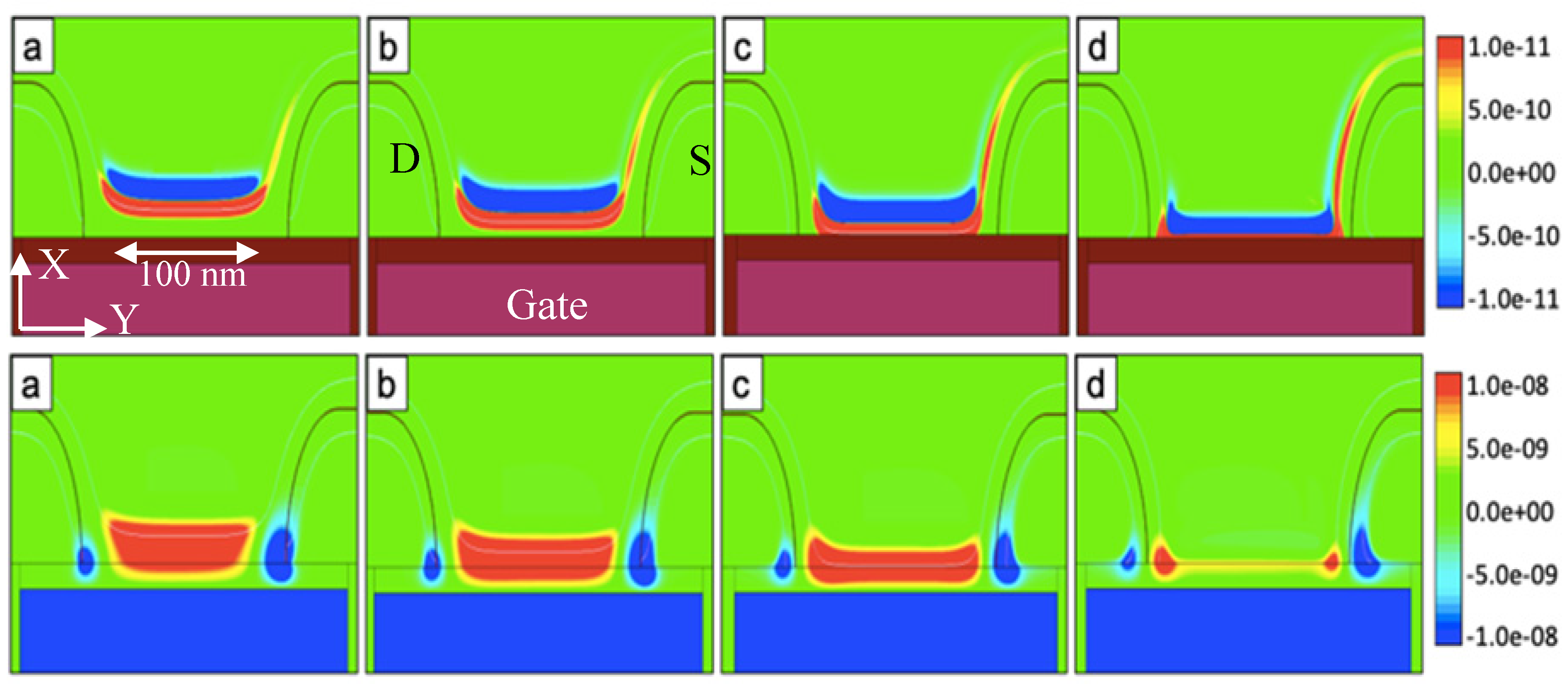
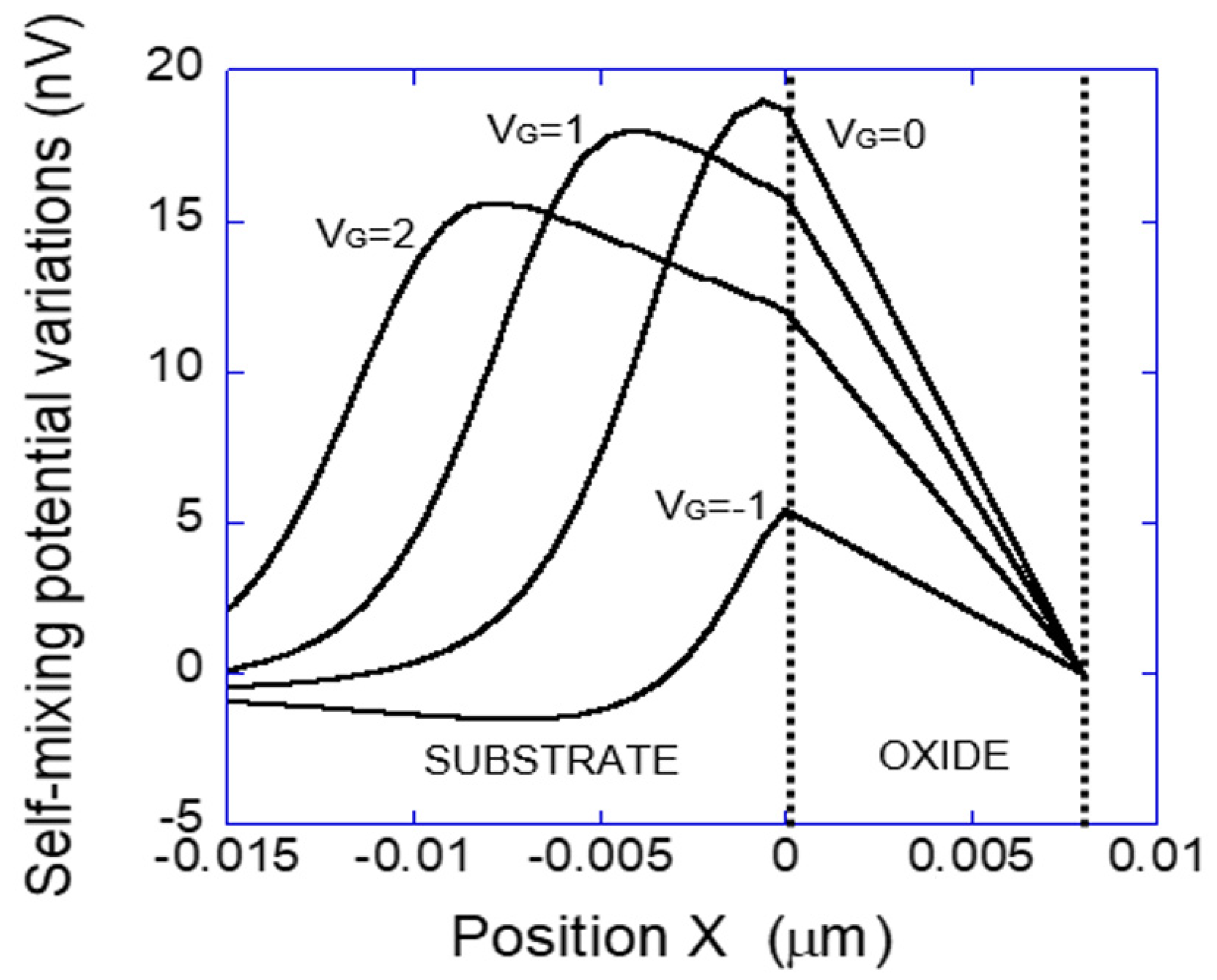
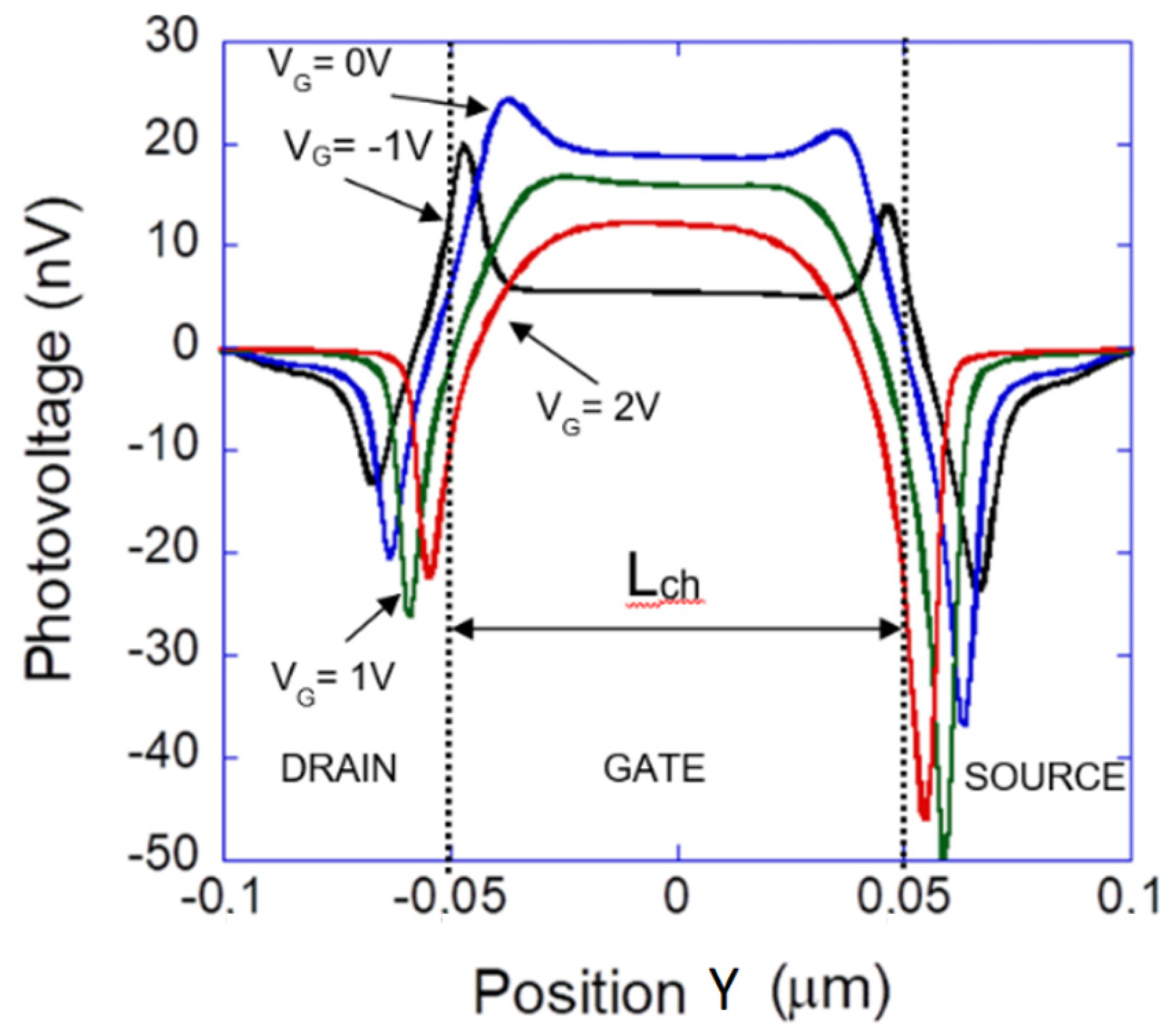
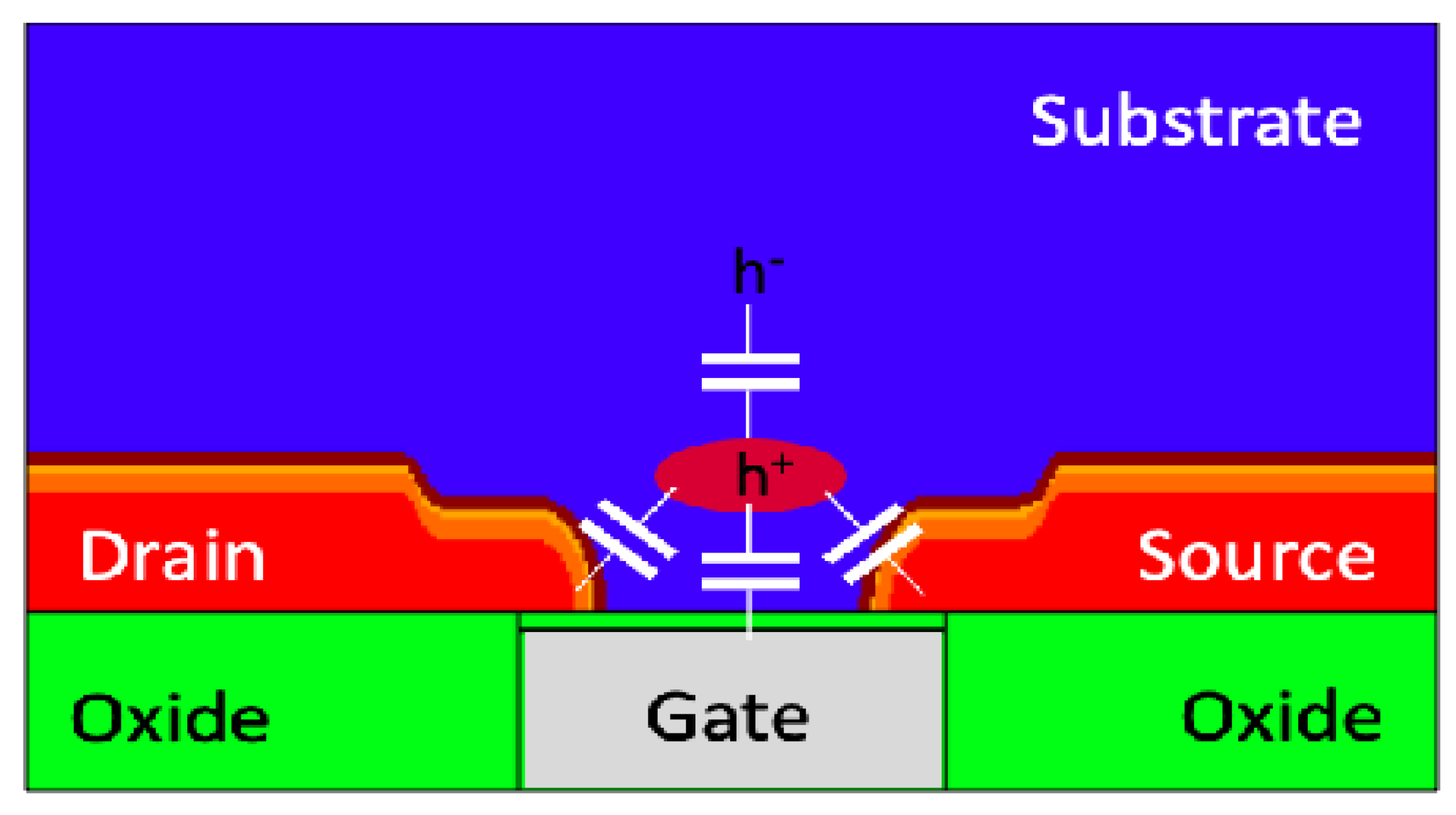


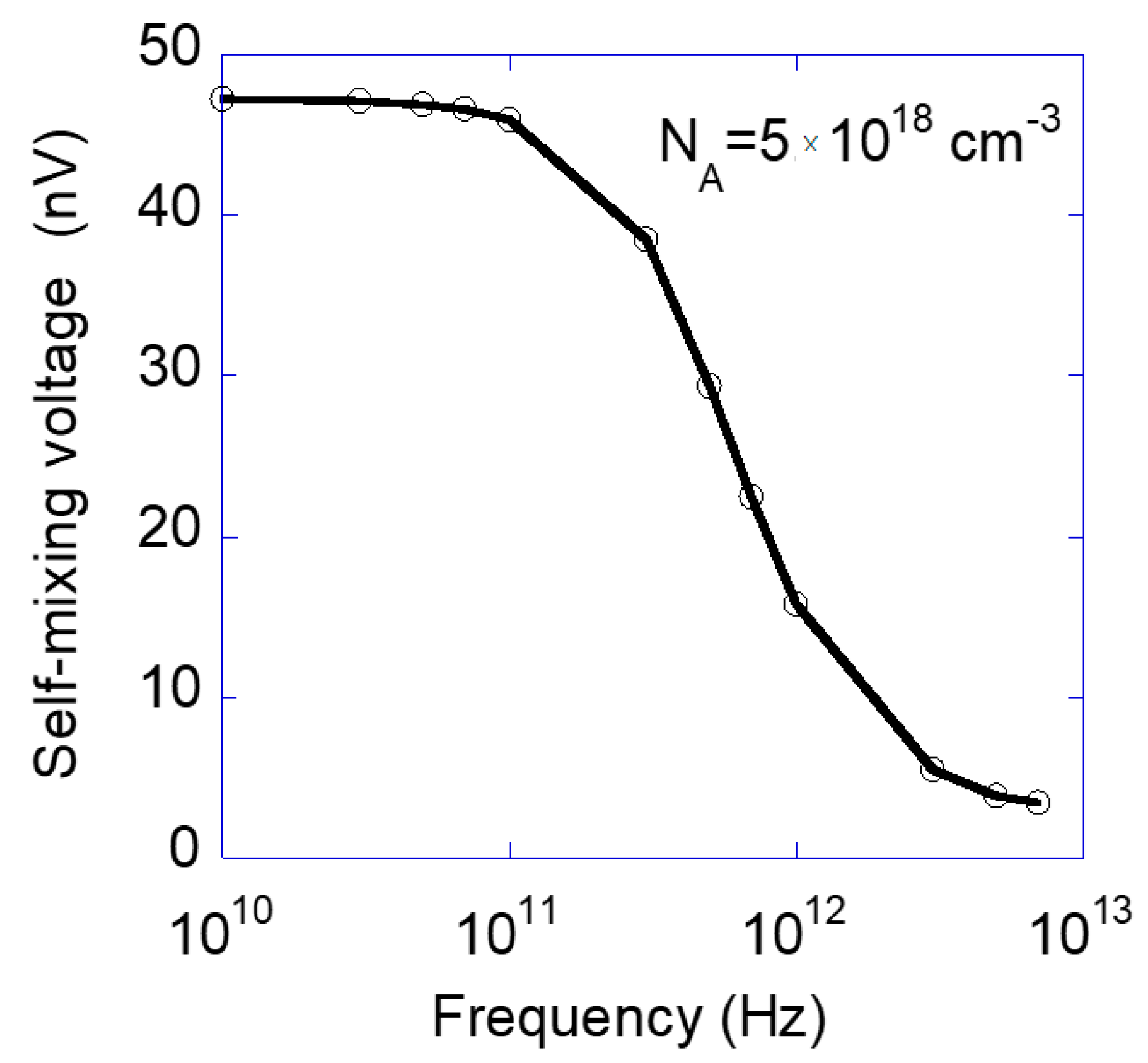
© 2020 by the author. Licensee MDPI, Basel, Switzerland. This article is an open access article distributed under the terms and conditions of the Creative Commons Attribution (CC BY) license (http://creativecommons.org/licenses/by/4.0/).
Share and Cite
Palma, F. New Insight on Terahertz Rectification in a Metal–Oxide–Semiconductor Field-Effect Transistor Structure. Electronics 2020, 9, 1089. https://doi.org/10.3390/electronics9071089
Palma F. New Insight on Terahertz Rectification in a Metal–Oxide–Semiconductor Field-Effect Transistor Structure. Electronics. 2020; 9(7):1089. https://doi.org/10.3390/electronics9071089
Chicago/Turabian StylePalma, Fabrizio. 2020. "New Insight on Terahertz Rectification in a Metal–Oxide–Semiconductor Field-Effect Transistor Structure" Electronics 9, no. 7: 1089. https://doi.org/10.3390/electronics9071089




